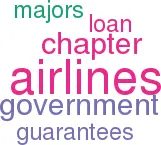The Chapter 11 domino threat
October 2001


The US Congress accepted the inevitable when it put together an emergency state aid package for its industry.
The key elements of the Air Transportation Safety and System Stabilization Act are as follows:
- $5bn in immediate grants allocated according to capacity (about $4bn to the Majors);
- $10bn in loan guarantees to airlines near bankruptcy;
- Limitations on airlines' liability for the attacks to the maximum of their insurance coverage;
- Government guaranteed war risk insurance for 180 days and reimbursement for premium increases;
- Airlines receiving loan guarantees have to give the government purchase options in their companies, the intention being that the government will have the opportunity to benefit from a restoration in the industry’s fortunes;
- DoT is authorised to audit losses estimated or reported by the airlines; and
- A two–year pay freeze for executives of airlines getting loan guarantees if they already are paid more than $300,000 a year.
As an immediate response to an impossible situation the US government package looks reasonable, but is it enough to prevent the Chapter 11 domino effect. In this scenario once the weakest carriers (US Airways, then Northwest then America West) has sought Chapter 11, other carriers which might have been able to continue trading normally will also be tempted in Chapter 11 in order to avoid increased fare competition from the creditor–protected airlines.
Early estimates of the impact of September 11 on the US Majors' finances show a predicted net loss for 2001 of nearly $5bn compared to previous predictions of $2.4bn (which was very poor in itself). The tangible equity base (this excludes goodwill and intangibles) would be eroded by about a third. Also worrying is the working capital balance. Normally airlines operate quite happily with negative working capital as the short–term liabilities are largely composed of sold but unused air tickets; but this may become a "real" liability in the post- September 11 market.
The only carrier that looks really solid is Southwest. Its point–to–point, purely domestic operations are robust, and early indications from that carrier are that its traffic is holding up. The network Majors have adopted concerted 20% reduction in capacity programmes with commensurate job losses. They now have to address the worrying question of how to adapt their mega–hub systems and 150–seater jet fleets to the new security environment.
| Tangible | Cash | Pre-Sept 11 | Post-Sept 11 | |||
| equity short-term invest. Working capital | est. 2001 earnings | est. 2001 earnings | ||||
| Southwest | 3,822 | 968 | -300 | 550 | 418 | |
| Delta | 2,813 | 1,510 | -3,165 | -460 | -804 | |
| United | 4,061 | 1,280 | -3,657 | -1,150 | -1,685 | |
| American | 5,329 | 1,487 | -2,720 | -550 | -1,133 | |
| Continental | 195 | 1,008 | -1,001 | 110 | -100 | |
| Northwest | -606 | 1,350 | -1,345 | -270 | -522 | |
| US Airways | -1,371 | 1,250 | -369 | -570 | -816 | |
| Alaska | 782 | 371 | -18 | -15 | -66 | |
| Am West | 329 | 174 | -234 | -70 | -129 | |
| Industry | 15,354 | 9,398 | -12,809 | -2,425 | -4,837 | |
| Source: V. Cordle/Planebusiness.com | ||||||
| United | 780 |
| America | 718 |
| Delta | 652 |
| Northwest | 460 |
| Continental | 384 |
| US Airways | 316 |
| Southwest | 288 |
| AmWest | 120 |
| Alaska | 20 |
| Total | 3,738 |